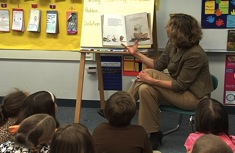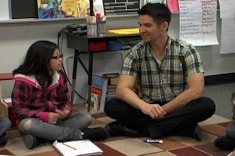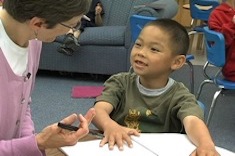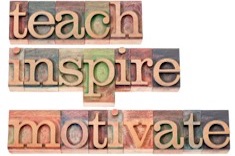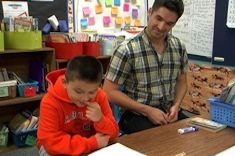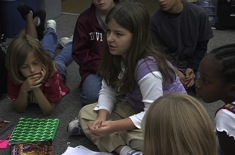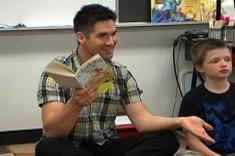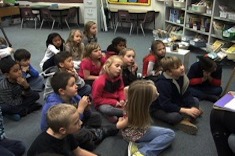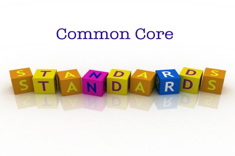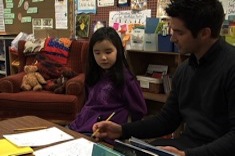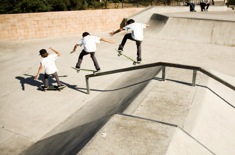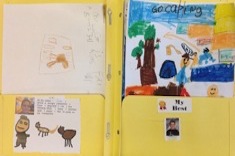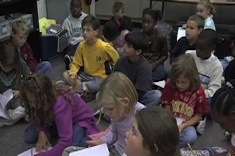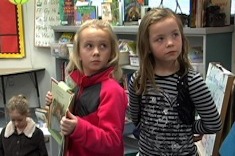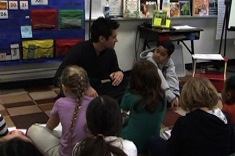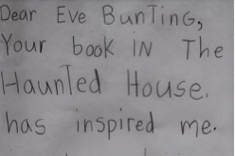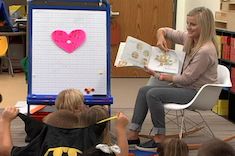2nd
Latest Content
Integrating Vocabulary and Retelling Strategies into Read-Aloud
Stella Villalba scaffolds the language development of her first- and second-grade English language learners during read-aloud by highlighting vocabulary and providing a tool to assist with a partner retelling activity.
Backing Up and the Bossy E
In this conference with second grader TJ from Sean Moore’s classroom, the strategies of backing up and rereading as well as attending to the “bossy e” are discussed.
Building Peer Conferring Skills in the Primary Grades
Ann Marie Corgill questions whether her second graders are ready for peer response. She finds that with some guidance and construction of anchor charts together, the answer is a resounding yes.
Previewing and Picture Walks with Fiction Texts
Clare Landrigan and Tammy Mulligan provide previewing how-to advice for grades K-2 teachers.
Book Matchmaker: Nonfiction to Read Cover to Cover
With the Common Core emphasis on nonfiction, teachers are striving to integrate more nonfiction texts throughout their literacy workshops. Franki Sibberson shares her favorite nonfiction texts that can be read cover to cover.
Second Grade Whole-Class Share: Adding Details and Descriptive Language Part 4
In this final video from a four-part series, Sean Moore asks students to share their writing with peers and the whole class.
Second Grader Student Mentor Text: Adding Details and Descriptive Language Part 3
In this third video from a four-part series, Sean Moore has a student share his writing as a mentor text for the class.
Hearing Carlos: Helping Young English Language Learners Develop Speaking and Listening Skills
Stella Villalba incorporates more speaking and listening activities into her primary classroom for English language learners.
Writers Inspiring Writers
Melissa Styger invites colleagues and family members into the classroom to share their writing process with students.
Second Grader Conferring: Adding Details and Descriptive Language Part 2
In this second video from a four-part series, Sean Moore confers with a student about adding details to his writing.
Eliminating the Conga Line: Teaching Young Children About Strategic Thinking
Clare Landrigan and Tammy Mulligan manage to synthesize workspace cleanup, student independence, and a concrete analogy for strategy work in classrooms.
Peer Conferring: The “Try It On” Phase
Amanda Adrian continues her series on how teachers can scaffold and model peer conferring. In this installment, Amanda uses the fishbowl technique with students.
Second-Grade Writing: Adding Details and Descriptive Language
In this first video from a four-part series, Sean Moore leads a writing workshop focused on adding more details and descriptive language to writing. He begins with the classic Charlotte’s Web as his mentor text.
Quick Sketch Practice
Linda Karamatic uses quick sketches to teach her second graders about sensory images in reading. This is the second installment in a two-part series.
Quick Sketch Sensory Images Read Aloud: Introduction
Linda Karamatic uses quick sketches to teach her second graders about sensory images in reading. This is the first installment in a two-part series.
Common Core Booklist: Writing Personal Narratives
Personal narratives are an important part of the Common Core in 4th grade. Franki Sibberson shares a booklist of some of her favorite mentor texts for teaching narratives in the intermediate grades.
Informational Snapshot Writing
Heather Rader finds web video is a powerful tool for scaffolding young writers as they produce informational texts.
Mixing Information and Narratives
In this conference from a second-grade classroom, Sean Moore helps Mia flesh out her writing on friendship with examples.
Peer Conferring: The Modeling Phase
Amanda Adrian provides a framework, sample model lesson, and peer conferring guide for students to use as they learn how to respond to their classmates.
Formative Assessment: Wall Displays and Conversations in First Grade
Formative assessments are always a priority in classrooms. Cathy Mere explains how she uses a classroom wall display and conversations to highlight strong writing and help her first graders learn to assess improvements in their work.
Book Matchmaker: Read Aloud Versions of Old Favorites
Franki Sibberson presents some delightful versions of classic tales perfect for read alouds with youngsters.
From Reading to Writing Informational Texts
Aimee Buckner makes some surprising discoveries about what types of texts support writers working in nonfiction genres.
Launching a Punctuation Study in Second Grade
Linda Karamatic is launching a unit on punctuation with her second graders which includes mentor texts, inquiry, and anchor charts.
Chronology in Nonfiction (Common Core Booklist)
Franki Sibberson's latest Common Core booklist includes texts to help students master chronology in nonfiction.
Enlisting a Student as Coteacher
In this second video in a two-part series, Sean Moore invites second grader Isaiah to present his learning to the class.
The Blank Page and Better Teaching
Aimee Buckner learns some important lessons about how images and words work together for student writers when she moves between second- and fifth-grade classrooms.
Conferring to Coteaching
In this first video in a two-part series, Sean Moore confers with second grader Isaiah. Sean prepares Isaiah to share what he is learning later in the writing workshop.
Dear Eve Bunting
A persistent seven-year-old has some powerful messages about confidence, patience, and sending writing out into the world.
When Are Students Ready for Writers’ Notebooks?
Second grade? Third grade? Aimee Buckner breaks down what behaviors to look for if you’re trying to determine when students are ready to move from draft pages or booklets to writers’ notebooks.
Field Experience: Social-Emotional Learning in Workshop
Compassion and understanding are as important to workshop instruction as strategies and routines. Ruth Ayres compiled a field experience to highlight the way understanding the social-emotional needs of students (and ourselves) allows for safe learning environments.
Browse Content By
Type
Category
- Assessment Tools
- Big Fresh Archives
- Booklists
- Choice Numeracy
- Classroom Design
- Common Core
- Community Building
- Conferring
- Content Literacy
- Digital Literacy
- English Language Learners
- Equity
- Family Relations
- Free Samples
- Guiding Groups
- Leadership
- Literacy Coaches
- Mentor Texts
- Minilessons
- New Teacher Mentors
- Podcasts
- Poetry
- Quote Collections
- Reading Strategies
- Self Care
- Struggling and Striving Learners
- Talking and Listening
- Teacher Study Groups
- Teaching Reading
- Teaching Writing
- Word Study and Vocabulary
Author
- Melissa Quimby
- Nawal Qarooni
- Gwen Blumberg
- Julie Cox
- The Lead Learners
- Hannah Tills
- Josie Stewart
- Ruth Metcalfe
- Mallory Messenger
- Becca Burk
- Jodie Bailey
- Vivian Chen
- Mary Brower
- Tiffany Abbott Fuller
- Stephanie Affinito
- Ruth Ayres
- Leigh Anne Eck
- Heather Fisher
- Shari Frost
- Julie Johnson
- Suzy Kaback
- Gigi McAllister
- Shirl McPhillips
- Melanie Meehan
- Cathy Mere
- Debbie Miller
- Tara Barnett and Kate Mills
- Tammy Mulligan
- Dana Murphy
- Bitsy Parks
- David Pittman
- Brenda Power
- Heather Rader
- Matt Renwick
- Mandy Robek
- Christy Rush-Levine
- Gretchen Schroeder
- Jen Schwanke
- Brian Sepe
- Katherine Sokolowski
- Stella Villalba
- Jennifer Vincent
Grade Level
Choice Literacy Membership
Articles
Get full access to all Choice Literacy article content
Videos
Get full access to all Choice Literacy video content
Courses
Access Choice Literacy course curriculum and training




